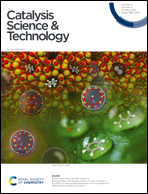Ligand-coordinated Ir single-atom catalysts stabilized on oxide supports for ethylene hydrogenation and their evolution under a reductive atmosphere†
Abstract
In this work, we present a novel series of oxide-supported Ir-ligand single-atom catalysts (SACs) for ethylene hydrogenation. The SACs were created by a metal–ligand self-assembly strategy developed by our group, using one of two ligands, either 1,10-phenanthroline-5,6-dione (PDO) or 3,6-Di-2-pyridyl-1,2,4,5-tetrazine (DPTZ), on powder supports of either CeO2 or MgO. Characterization by XAS, XPS, and CO adsorption proved that Ir exist principally as highly uniform, cationic single-atoms. Ir SACs show significantly higher durability and metal utilization efficiency than Ir nanoparticle (NP) catalysts during ethylene hydrogenation at 100 °C, as well as excellent stability, as no Ir aggregates were detected after >10 h reaction. The activity can be tuned by ligand and support effects: PDO and CeO2 are superior to DPTZ and MgO, respectively. This tunability is attributed to differences in H2 activation capability, which results from differences in support reducibility, electron density on Ir, and, potentially, the local coordination environment of Ir. The Ir SACs lose H2 activation activity either under inert gas or under H2. Through XPS and in situ XAS studies, we attributed the former to the reversible loss of Ir hydride, which is the active species for H2 activation, and the latter to irreversible over-hydrogenation and loss of Ir–O/N coordination. This work presents a new type of Ir hydrogenation SACs that are more durable, efficient, and tunable than supported Ir NPs, while more stable than homogeneous Ir complexes. It also offers fundamental understanding regarding ligand and support effects, as well as the evolution of Ir single-atoms under H2, instructing future design of stable, effective hydrogenation SACs.



 Please wait while we load your content...
Please wait while we load your content...
